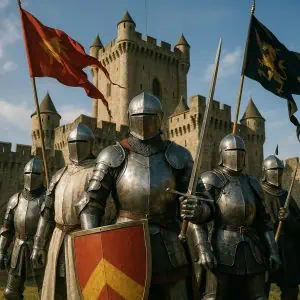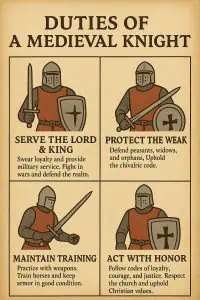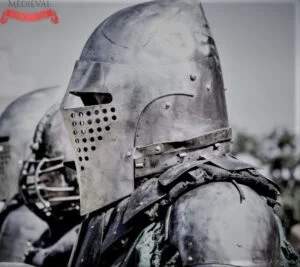Explore the fascinating world of medieval knights and discover the 10 distinct types of knights that shaped the course of European history. From the elite warriors of feudal lords to the religious crusaders of the Holy Land, each type of knight held a unique role in the complex social and military structure of the Middle Ages. These knights of honor were more than just armored fighters—they were symbols of loyalty, valor, and chivalry, bound by codes of conduct and driven by duty. Whether serving kings, defending pilgrims, or seeking glory in tournaments, these knights played a crucial part in shaping medieval warfare, politics, and culture.

However, not all medieval knights were the same—their roles, duties, and privileges varied greatly depending on their social status, training, and allegiance. Some served directly under kings, while others belonged to religious military orders or roamed as knights-errant in search of glory. Let’s delve into the different types of knights in the Middle Ages and explore what set each group apart in terms of honor, responsibility, and military rank.
“Knights were the embodiment of noble virtues, their unwavering commitment to chivalry shaped the very essence of medieval society.”
Dr. Catherine Turner, Historian of Medieval Knighthood.
1. Knight Bachelor
A knight bachelor was the most basic form of knighthood, typically bestowed upon individuals for their martial achievements or service to a lord. They were not part of a knightly order and did not hold any specific titles or lands. Knight bachelors fought as individuals and often served as skilled warriors or household retainers.
2. Banneret
Bannerets were knights who had proven their valor on the battlefield. They were entitled to lead a company of knights under their own banner, which granted them a higher status and command authority. Bannerets were often appointed by kings or nobles and played significant roles in military campaigns.
3. Knight Hospitaller
Knight Hospitallers were members of the Order of Knights Hospitaller, a religious military order founded to provide medical and military assistance during the Crusades. They combined their knightly duties with tending to the sick and wounded. Knight Hospitallers held considerable influence and owned vast estates and fortifications.
4. Knight Templar
Knight Templars were members of the Order of the Knights Templar, another prominent religious military order during the Crusades. They were known for their martial skill and served as elite warriors in various conflicts. Knight Templars held great wealth and power, managing extensive estates and engaging in financial activities.
5. Knight of the Garter
Knights of the Garter were part of the Order of the Garter, an esteemed chivalric order established by King Edward III of England. They were selected from the nobility and were recognized for their exceptional service and loyalty to the crown. Knights of the Garter played prominent roles in courtly life and royal ceremonies.
6. Knight of the Golden Fleece
Knights of the Golden Fleece were members of the Order of the Golden Fleece, a prestigious chivalric order founded by Philip the Good, Duke of Burgundy. They were selected from the nobility and were known for their prowess in battle and political influence. Membership in the order signified high social status and honor.
7. Knight Errant
Knight errants were wandering knights who traveled in search of adventures and quests. They often sought to uphold chivalric values, rescue damsels in distress, and fight for justice. Knight errants were romanticized figures in medieval literature, embodying the ideals of gallantry and heroism.
8. Knight Marshal
The knight marshal held an important administrative and military position in the royal court. They were responsible for overseeing the king’s stables, organizing tournaments, and maintaining order in the field. Knight marshals were skilled warriors and played crucial roles in military logistics and strategy.
9. Knight Champion
A knight champion was an appointed champion who represented the honor and prowess of a noble family. They would engage in judicial combat to resolve disputes or defend the honor of their lord. Knight champions were chosen for their exceptional skill in combat and served as champions of justice and loyalty.
10. Knight Commander
Knight commanders were high-ranking knights who held leadership positions within knightly orders or military organizations. They were responsible for the administration and training of other knights, ensuring discipline and adherence to the knightly code. Knight commanders played pivotal roles in shaping the conduct and ideals of knighthood.
In the realm of medieval chivalry, the noble order of knights stands tall as a symbol of honor, valor, and loyalty. From the well-known knights in shining armor to the lesser-known specialized warriors, each type adds a unique facet to the tapestry of knighthood.

As we delve into the lives and roles of these ten distinct medieval knights, we not only witness their remarkable diversity but also gain a deeper appreciation for their significant contributions to the era’s history and legacy.
“From gallant paladins to fearless Templars, each type of medieval knight left an indelible mark on history, defining the code of honor that resonates even in the modern age.”
Prof. William Marshall, Medieval Studies Scholar.
Their tales of courage, gallantry, and dedication continue to inspire and captivate us, reminding us of a time when honor and duty were paramount in the heart of every knight.

10 Different Types of Medieval Knight | Great Books
“The Knight in History” by Frances Gies
This well-researched book provides a comprehensive history of knights, exploring their origins, roles, and evolution throughout the medieval period.
“Knights: The Complete Story of the Age of Chivalry” by Charles Phillips
This beautifully illustrated book offers a captivating overview of medieval knights, from their training and weapons to their pivotal role in shaping the era’s events.
“The Templars: The Rise and Spectacular Fall of God’s Holy Warriors” by Dan Jones
Focusing on the legendary Templar knights, this book unravels the mysteries and legends surrounding the iconic military order.
“The Romance of the Rose” by Guillaume de Lorris and Jean de Meun
This medieval allegorical poem depicts the concept of chivalry and the ideals of a medieval knight through its central character, the Lover.
“Knight: The Medieval Warrior’s (Unofficial) Manual” by Michael Prestwich
A delightful and engaging read, this book offers a lively exploration of the life and customs of medieval knights, making history come alive through practical and entertaining details.
These books provide a range of perspectives on medieval knights, from historical accounts to literary works. Enjoy your journey into the world of chivalry and honor!
What were the different types of knights in medieval times?
There were many types of medieval knights, each with specific roles, loyalties, and ranks. Some served kings or powerful lords, while others fought for religious or military orders. Their duties and titles often reflected their training, background, and whom they served.
What is a feudal knight?
A feudal knight was a noble warrior who pledged loyalty to a lord or king in exchange for land and protection. In return, the knight provided military service and upheld the feudal code of honor.
What is a crusader knight?
Crusader knights were those who took part in the Crusades, a series of religious wars during the medieval period. These knights often belonged to religious military orders like the Knights Templar or Hospitallers and fought to reclaim the Holy Land.
Who were the Knights Templar?
The Knights Templar were a powerful religious military order founded in the 12th century. They were known for their discipline, wealth, and key role in the Crusades. They took vows of poverty, chastity, and obedience, and protected pilgrims traveling to Jerusalem.
What is a knight-errant?
A knight-errant was a wandering knight who traveled in search of adventure, battles, and ways to prove their honor. Popular in medieval romance literature, they often fought for justice and sought to protect the weak.
What is a banneret knight?
A banneret knight was a higher-ranking knight who commanded his own troops and was allowed to carry a square banner into battle. They usually held more land and influence than ordinary knights.
Who were household knights?
Household knights served directly under a king or lord and were part of their personal retinue. They lived within the noble’s household and provided immediate military and political support.
What is a knight bachelor?
A knight bachelor was the most basic rank of knighthood. These knights did not command other knights and typically served under more senior nobles or military leaders.
Who were the Teutonic Knights?
The Teutonic Knights were a Catholic religious military order formed in the late 12th century. Based in Central and Eastern Europe, they played a major role in crusading efforts and territorial conquests, especially in the Baltic region.
What was the role of knights in tournaments?
Tournaments were mock battles and competitions where knights could display their skills, gain honor, and win prizes. These events were both entertainment and training exercises, helping knights prepare for real combat.






